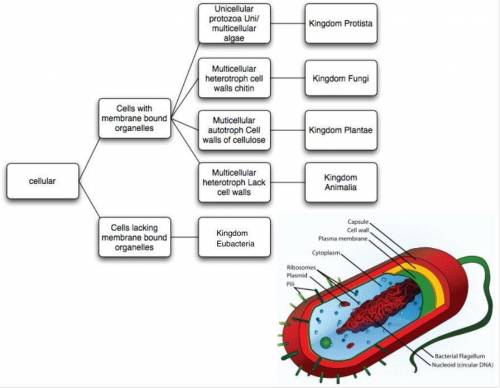
Biology, 12.05.2021 01:10 TornSnowFlake336
In the 18th century, Carl Linnaeus published a system for classifying living things, which has been developed into the modern classification system. Recently the classification system of life was changed to include not five but six kingdoms, as well as three domains. Earlier classification attempts were based mostly on structural features. Classification of many species, old and new, continues to be hotly disputed as scientists find new information or interpret facts in new ways. Now, DNA technology has allowed scientists to re-examine the relationships between organisms to refine the classification system. The Kingdom Monera in the old classification system included all bacteria. What two kingdoms now encompass prokaryotic organisms? A) Bacteria and Archaea B) Eubacteria and Archaea C) Bacteria and Archaebacteria D) Eubacteria and Archaebacteria


Answers: 3


Other questions on the subject: Biology

Biology, 21.06.2019 23:30, stankyweezle
In iceland, the mid atlantic ridge runs through the center of the contry. what can you conclude about the apperence of iceland many thousands of years from now?
Answers: 1

Biology, 22.06.2019 08:00, kellysmith45
Residential construction is expanding in florida, the expansion has caused fragmentation of habitats, one of the results of the increased construction is a decrease in the number of large predators such as the coyote, black bear and pool panther, which will be the most immediate local result of this fragmentation? 1)large predators will become extinct 2)decrease in middle sized predators 3)increase in population of top carnivores 4)increase in population of prey species
Answers: 1

Biology, 22.06.2019 10:30, nonjabulomabaso7423
Subduction zones form when an oceanic plate collides with another oceanic plate or continental plate. the continental crust is lighter and less dense than oceanic crust. continental crust's density is approximately 2.7 grams per cubic centimeter. oceanic crust is thinner and the average density is about 3.3 cubic centimeters. when the two crustal plates converge the oceanic plate always bends and subducts beneath a continental plate. once the oceanic crust subjects, the rocks are subjected to changes in heat and pressure. because of this, we would expect to find rocks in the area of a subduction. a) clastic b) igneous c) metamorphic d) sedimentary
Answers: 2

Biology, 22.06.2019 12:30, shardaeheyward4556
Describe the relationship between isotonic solutions, equilibrium, and water movement into and out of a cell.
Answers: 1
You know the right answer?
In the 18th century, Carl Linnaeus published a system for classifying living things, which has been...
Questions in other subjects:




History, 06.07.2019 17:00


Mathematics, 06.07.2019 17:00

Mathematics, 06.07.2019 17:00

Biology, 06.07.2019 17:00

Spanish, 06.07.2019 17:00

Mathematics, 06.07.2019 17:00



